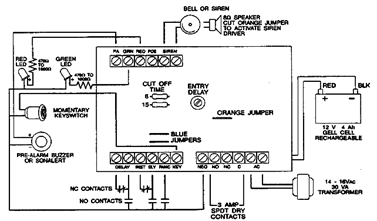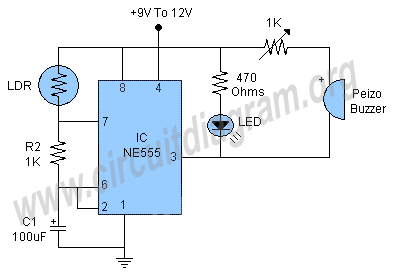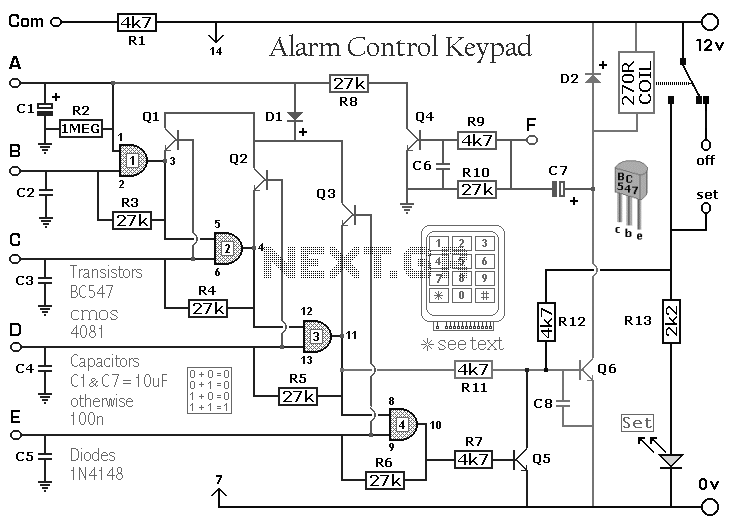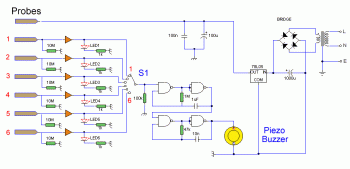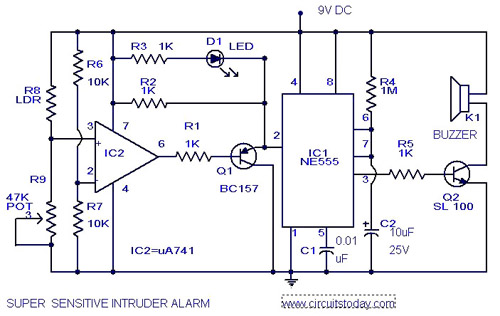
4 Digit Alarm Keypad

The Keypad must be the kind with a common terminal and a separate connection for each key. On a 12-key pad, look for 13 terminals. The matrix type with 7 terminals will NOT do. The Alarm is set by pressing a single key. Choose the key you want to use and wire it to E. Choose the four keys you want to use to switch the alarm off, and connect them to A B C & D. Your code can include the non-numeric symbols. With a 12-key pad, over 10,000 different codes are available. Wire the common to R1 and all the remaining keys to F. When E is pressed, current through D2 and R9 switches Q5 on. More: The relay energises, and then holds itself on by providing base current for Q5 through R10. The 12-volt output is switched from the "off" to the "set" terminal, and the LED lights. To switch the Alarm off again it is necessary to pre.
The described circuit utilizes a 12-key keypad configured with a common terminal, which allows for individual connections for each key. This configuration is essential for ensuring that each keypress can be detected independently, facilitating the setting and resetting of an alarm system. The keypad features a total of 13 terminals, with one common terminal connected to a resistor (R1), which serves as the reference point for the keys.
When a specific key is pressed to set the alarm, it is connected to terminal E. This action initiates a current flow through diode D2 and resistor R9, which in turn activates transistor Q5. The activation of Q5 allows for the energization of a relay, which is responsible for switching the alarm system from the "off" state to the "set" state.
To deactivate the alarm, four additional keys must be selected and connected to terminals A, B, C, and D. This feature enhances security by allowing a range of codes, including non-numeric symbols, thus providing over 10,000 possible combinations for user codes.
Once the relay is activated, it maintains its state by providing feedback through resistor R10, ensuring that Q5 remains in the 'on' state even after the initial keypress is released. The circuit also incorporates an LED indicator that illuminates when the alarm is active, providing a visual cue of the system status.
The design of this circuit emphasizes reliability and user-friendly operation, making it suitable for various alarm applications. The careful selection of components and their arrangement ensures that the system is both effective and efficient in its function.The Keypad must be the kind with a common terminal and a separate connection for each key. On a 12-key pad, look for 13 terminals. The matrix type with 7 terminals will NOT do. The Alarm is set by pressing a single key. Choose the key you want to use and wire it to `E`. Choose the four keys you want to use to switch the alarm off, and connect them to `A B C & D`. Your code can include the non-numeric symbols. With a 12-key pad, over 10 000 different codes are available. Wire the common to R1 and all the remaining keys to `F`. When `E` is pressed, current through D2 and R9 switches Q5 on. The relay energises, and then holds itself on by providing base current for Q5 through R10. The 12-volt output is switched from the "off " to the "set " terminal, and the LED lights. To switch the Alarm off again it is necessary to pre 🔗 External reference
The described circuit utilizes a 12-key keypad configured with a common terminal, which allows for individual connections for each key. This configuration is essential for ensuring that each keypress can be detected independently, facilitating the setting and resetting of an alarm system. The keypad features a total of 13 terminals, with one common terminal connected to a resistor (R1), which serves as the reference point for the keys.
When a specific key is pressed to set the alarm, it is connected to terminal E. This action initiates a current flow through diode D2 and resistor R9, which in turn activates transistor Q5. The activation of Q5 allows for the energization of a relay, which is responsible for switching the alarm system from the "off" state to the "set" state.
To deactivate the alarm, four additional keys must be selected and connected to terminals A, B, C, and D. This feature enhances security by allowing a range of codes, including non-numeric symbols, thus providing over 10,000 possible combinations for user codes.
Once the relay is activated, it maintains its state by providing feedback through resistor R10, ensuring that Q5 remains in the 'on' state even after the initial keypress is released. The circuit also incorporates an LED indicator that illuminates when the alarm is active, providing a visual cue of the system status.
The design of this circuit emphasizes reliability and user-friendly operation, making it suitable for various alarm applications. The careful selection of components and their arrangement ensures that the system is both effective and efficient in its function.The Keypad must be the kind with a common terminal and a separate connection for each key. On a 12-key pad, look for 13 terminals. The matrix type with 7 terminals will NOT do. The Alarm is set by pressing a single key. Choose the key you want to use and wire it to `E`. Choose the four keys you want to use to switch the alarm off, and connect them to `A B C & D`. Your code can include the non-numeric symbols. With a 12-key pad, over 10 000 different codes are available. Wire the common to R1 and all the remaining keys to `F`. When `E` is pressed, current through D2 and R9 switches Q5 on. The relay energises, and then holds itself on by providing base current for Q5 through R10. The 12-volt output is switched from the "off " to the "set " terminal, and the LED lights. To switch the Alarm off again it is necessary to pre 🔗 External reference
